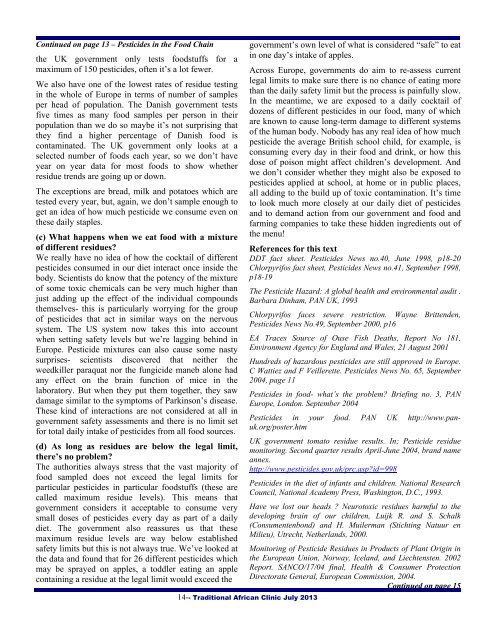toxicity - pesticides, herbicides and insecticides - Blackherbals.com
toxicity - pesticides, herbicides and insecticides - Blackherbals.com
toxicity - pesticides, herbicides and insecticides - Blackherbals.com
You also want an ePaper? Increase the reach of your titles
YUMPU automatically turns print PDFs into web optimized ePapers that Google loves.
Continued on page 13 – Pesticides in the Food Chainthe UK government only tests foodstuffs for amaximum of 150 <strong>pesticides</strong>, often it’s a lot fewer.We also have one of the lowest rates of residue testingin the whole of Europe in terms of number of samplesper head of population. The Danish government testsfive times as many food samples per person in theirpopulation than we do so maybe it’s not surprising thatthey find a higher percentage of Danish food iscontaminated. The UK government only looks at aselected number of foods each year, so we don’t haveyear on year data for most foods to show whetherresidue trends are going up or down.The exceptions are bread, milk <strong>and</strong> potatoes which aretested every year, but, again, we don’t sample enough toget an idea of how much pesticide we consume even onthese daily staples.(c) What happens when we eat food with a mixtureof different residues?We really have no idea of how the cocktail of different<strong>pesticides</strong> consumed in our diet interact once inside thebody. Scientists do know that the potency of the mixtureof some toxic chemicals can be very much higher thanjust adding up the effect of the individual <strong>com</strong>poundsthemselves- this is particularly worrying for the groupof <strong>pesticides</strong> that act in similar ways on the nervoussystem. The US system now takes this into accountwhen setting safety levels but we’re lagging behind inEurope. Pesticide mixtures can also cause some nastysurprises- scientists discovered that neither theweedkiller paraquat nor the fungicide maneb alone hadany effect on the brain function of mice in thelaboratory. But when they put them together, they sawdamage similar to the symptoms of Parkinson’s disease.These kind of interactions are not considered at all ingovernment safety assessments <strong>and</strong> there is no limit setfor total daily intake of <strong>pesticides</strong> from all food sources.(d) As long as residues are below the legal limit,there’s no problem?The authorities always stress that the vast majority offood sampled does not exceed the legal limits forparticular <strong>pesticides</strong> in particular foodstuffs (these arecalled maximum residue levels). This means thatgovernment considers it acceptable to consume verysmall doses of <strong>pesticides</strong> every day as part of a dailydiet. The government also reassures us that thesemaximum residue levels are way below establishedsafety limits but this is not always true. We’ve looked atthe data <strong>and</strong> found that for 26 different <strong>pesticides</strong> whichmay be sprayed on apples, a toddler eating an applecontaining a residue at the legal limit would exceed thegovernment’s own level of what is considered “safe” to eatin one day’s intake of apples.Across Europe, governments do aim to re-assess currentlegal limits to make sure there is no chance of eating morethan the daily safety limit but the process is painfully slow.In the meantime, we are exposed to a daily cocktail ofdozens of different <strong>pesticides</strong> in our food, many of whichare known to cause long-term damage to different systemsof the human body. Nobody has any real idea of how muchpesticide the average British school child, for example, isconsuming every day in their food <strong>and</strong> drink, or how thisdose of poison might affect children’s development. Andwe don’t consider whether they might also be exposed to<strong>pesticides</strong> applied at school, at home or in public places,all adding to the build up of toxic contamination. It’s timeto look much more closely at our daily diet of <strong>pesticides</strong><strong>and</strong> to dem<strong>and</strong> action from our government <strong>and</strong> food <strong>and</strong>farming <strong>com</strong>panies to take these hidden ingredients out ofthe menu!References for this textDDT fact sheet. Pesticides News no.40, June 1998, p18-20Chlorpyrifos fact sheet, Pesticides News no.41, September 1998,p18-19The Pesticide Hazard: A global health <strong>and</strong> environmental audit .Barbara Dinham, PAN UK, 1993Chlorpyrifos faces severe restriction. Wayne Brittenden,Pesticides News No.49, September 2000, p16EA Traces Source of Ouse Fish Deaths, Report No 181,Environment Agency for Engl<strong>and</strong> <strong>and</strong> Wales, 21 August 2001Hundreds of hazardous <strong>pesticides</strong> are still approved in Europe.C Wattiez <strong>and</strong> F Veillerette. Pesticides News No. 65, September2004, page 11Pesticides in food- what’s the problem? Briefing no. 3, PANEurope, London. September 2004Pesticides in your food. PAN UK http://www.panuk.org/poster.htmUK government tomato residue results. In; Pesticide residuemonitoring. Second quarter results April-June 2004, br<strong>and</strong> nameannex.http://www.<strong>pesticides</strong>.gov.uk/prc.asp?id=998Pesticides in the diet of infants <strong>and</strong> children. National ResearchCouncil, National Academy Press, Washington, D.C., 1993.Have we lost our heads ? Neurotoxic residues harmful to thedeveloping brain of our children, Luijk R. <strong>and</strong> S. Schalk(Consumentenbond) <strong>and</strong> H. Muilerman (Stichting Natuur enMilieu), Utrecht, Netherl<strong>and</strong>s, 2000.14-- Traditional African Clinic July 2013Monitoring of Pesticide Residues in Products of Plant Origin inthe European Union, Norway, Icel<strong>and</strong>, <strong>and</strong> Liechtensten. 2002Report. SANCO/17/04 final, Health & Consumer ProtectionDirectorate General, European Commission, 2004.Continued on page 15
















